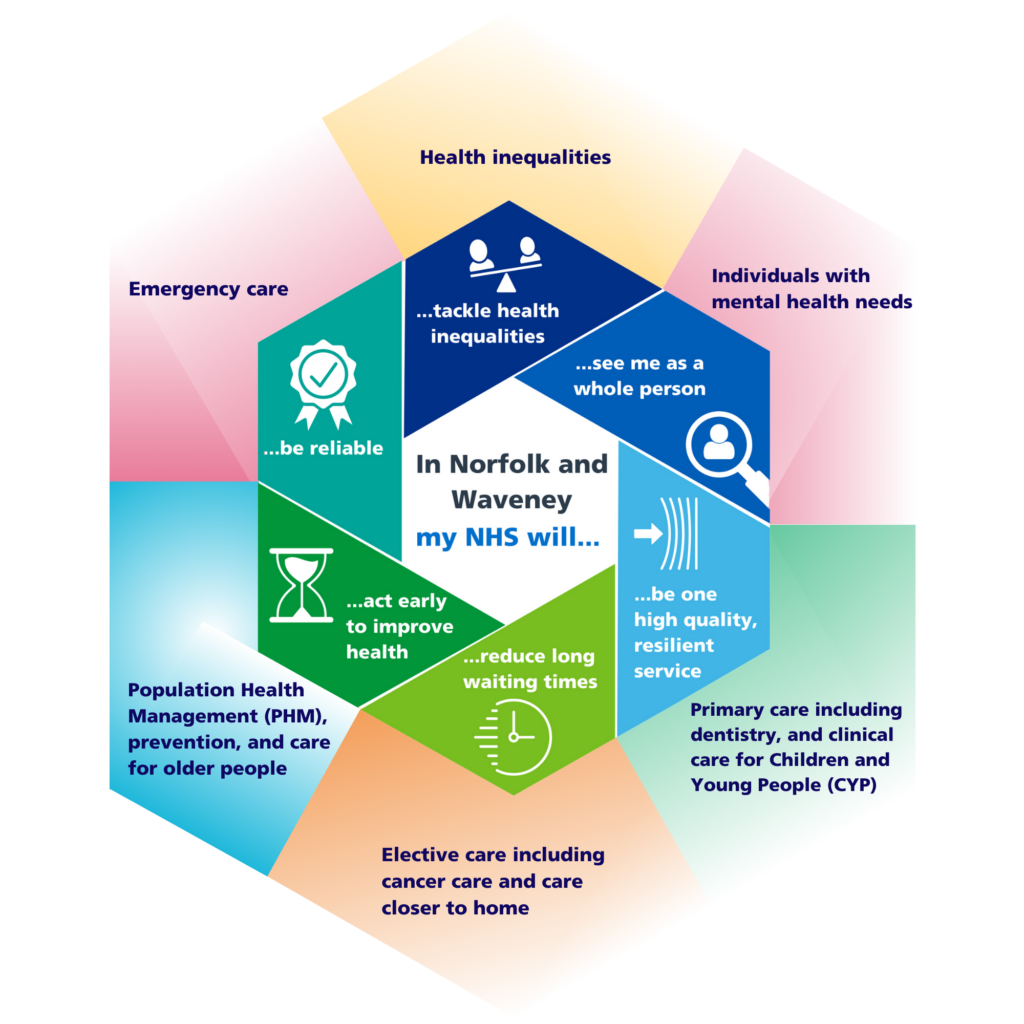
Background
The Norfolk and Waveney Clinical Strategy, launched in 2022, continues to guide the transformation of healthcare services in the region. Developed through patient and stakeholder engagement, the strategy is focused on six key objectives aimed at improving care, reducing inequalities, and ensuring that healthcare is accessible and resilient. A link to the strategy and two previous updates can be found here.
This progress report covers the period from April to September 2024 and highlights specific achievements in each of the six key objectives.
There is alignment between the ICS Clinical Strategy and the ICS 5-year Joint Forward Plan. You can read the JFP and previous updates here.
Objective 1: See me as a whole person – Focus on people with Mental Health Needs
You said: “I need better access to mental health services and want to avoid long waits or trips to the A&E.”
We did: We enhanced the Mental Health in Primary Care Model, streamlining access to mental health services directly through GP practices. This allows patients to receive timely mental health support in a familiar setting, reducing delays and removing the need for separate referrals.
Additionally, we commissioned the Joint Response Mental Health Vehicle in collaboration with EEAST and NSFT. Furthermore, we expanded our Short Stay Recovery House service by adding two more houses, providing an additional eight beds across Norfolk and Waveney. These initiatives deliver both psychological interventions and physical health support closer to home, reducing emergency department visits and offering more community-based care options.
Objective 2: Be one high quality resilient service – Focus on dentistry
You said: “Access to a dentist in an emergency is difficult, and I often struggle to get an appointment when I need urgent care.”
We did: We launched an Urgent Treatment Service Pilot for dental care, providing 1,900 emergency appointments monthly across 23 providers, significantly improving access to dental care for both children and adults in urgent need. The service offers essential care for those experiencing dental pain or other emergencies, helping to prevent avoidable hospital visits and ensuring that patients receive timely treatment.
This pilot programme has improved the availability of emergency dental appointments, especially in underserved areas.
Objective 3: Reducing long waiting times – Focus on elective care and cancer
You said: “I’ve been waiting too long for surgery and don’t want to travel miles away for my treatment.”
We did: To reduce waiting times for elective surgeries, the Norfolk and Norwich Orthopaedic Centre (NANOC 1) opened in July 2024. This facility has increased surgical capacity, especially for orthopaedics, allowing patients to receive timely treatment without needing to travel so far, and builds on the additional paediatric theatres complex which opened in January 2024. Two of the three planned outpatient imaging buildings are now open.
The first “Community Diagnostic Centre” was opened at the James Paget University hospital site in July 2024, with Queen Elizabeth Hospital site opened in September 2024. These centres are the first phase of providing additional imaging services for patients, with additional Community Diagnostic Centres opening within the James Paget’s forthcoming Orthopaedic Elective Hub in the autumn 2024, and at Northgate Hospital in Great Yarmouth in 2025.
Objective 4: Act early to improve health – Focus on Population Health and Care for older people
You said: “As I get older, I worry about falling. I want support to help me stay independent for as long as possible.”
We did: We introduced AI technology to identify individuals at high risk of falls, enabling early interventions such as exercise programmes, home adaptations, and other preventive measures.This proactive approach helps older adults remain independent and reduces their risk of falling. The AI-driven initiative has helped identify at-risk individuals early, allowing healthcare teams to intervene with preventive measures such as home adaptations and community support.
Objective 5: Be reliable – Focus on Urgent and Emergency Care
You said: “I want to avoid going to the hospital if possible, but I still need proper care.”
We did: We expanded our Virtual Ward Services to 165 beds, providing patients with hospital-level care in their own homes. This initiative helps reduce unnecessary hospital admissions while ensuring that patients receive the necessary medical care in a comfortable environment. The Virtual Ward Services have allowed more patients to receive hospital-level care at home, reducing the need for hospital admissions and easing pressure on hospital resources.
Objective 6: Tackle Health Inequalities – Focus on Inclusion Health Groups
You said: “It’s hard for people in my community to get access to vaccines or proper healthcare.”
We did: The WOW Bus continues to deliver essential healthcare services to underserved communities, administering over 1,000 COVID-19 vaccinations. We’ve expanded this service to include flu and pneumonia vaccines and are working to introduce spirometry testing to support individuals with respiratory conditions.
